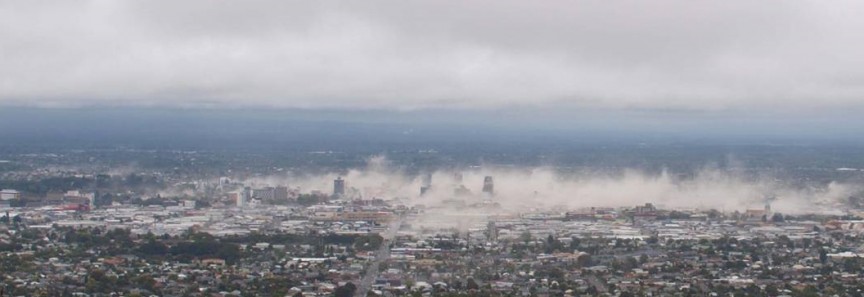Bullet Proof Glass
In some parts of the world you must be much more concerned about safety than in others. Generally it’s not a good idea to go into places where there’s conflict or danger unless you have a very good reason that can’t wait until after the smoke has cleared.

Bullet proof glass is a little extreme in most places – but sometimes it’s prudent to be prepared (this photo was taken in Baghdad at the height of 2007 internal conflict).
Security companies can be found in virtually every part of the world, and they usually will have various levels of protection (and associated cost). These firms are likely to have several ‘hardened’ vehicles available if you need a high level of certainty that you can safely get from point A to point B. That said, you probably want to be safe at point A and point B as well, so static security is also an important consideration in dangerous parts of the world (usually provided by higher end hotels – at various levels of rigor). I’m not going to write more about this today, but be assured that there are many more things that could be said.
One thing most people don’t realise about hardened car doors with bullet proof glass … is that they are very, very heavy to open and close.
Dad’s Recommendation:
Plan ahead – and consider safety before you journey. Bullet proof glass really does work, but isn’t a substitute for good planning. Safety is a sensible thing to consider, no matter where you travel.
Disaster Recovery – Overview
Some of you may know that I have been involved with some large scale disaster recovery efforts – from an infrastructure planning and reconstruction standpoint (tsunami in Sri Lanka, war in Iraq & Afghanistan, and earthquake in Christchurch, New Zealand), with recent expertise on Infrastructure Resilience.
In overview, it does seem like there are some very common phases which people may go through after a big disaster:
Denial – this isn’t happening to me!
Isolation – nobody understands what has happened to me!
Anger – this shouldn’t be happening to me!
Bargaining – what will it take to make this go away?
Depression – there is no hope of ending what has happened to me!
Acceptance – this happened to me, and here’s what I’m going to do.
The phases above are commonly associated with the grief cycle, which is a little different to the disaster recovery cycle which could be defined as:
Preparation – the best benefit for every dollar invested – not well publicised
Disaster Event – it’s never convenient or expected – more often captured on handheld smartphones etc
Response – civil defense, search and rescue, and emergency services – all on TV
Restoration – temporary restoration of services, facilities, and infrastructure (aka short-term recovery)
Reconstruction – permanent restoration of services, facilities, and infrastructure (aka long-term recovery)
Improvements – the addition of systems, methods and materials that we didn’t have before (aka mitigation measures)
-
Debris removal and “make-safe” measures
-
Demolition of unsafe structures
-
Protection of iconic heritage structures
-
Repair or reconstruction of infrastructure
-
Repair or reconstruction of damaged homes
-
Repair or reconstruction of community facilities
-
Repair or reconstruction of iconic city facilities
However, the common problem in the implementation of these works is that we need empowered leaders who communicate and engage with the appropriate stakeholders at the appropriate time, to develop collaborative outcomes that everyone can embrace and support. Further, there are another six phases which we should be aware of – common to many projects and apparently they are also common to recovery. I’ve added some phrases which you might hear … or more likely won’t:
- Enthusiasm (“We’ll fix everything back better than it was before”)
- Dissillusionment (“We’ll never be able to achieve everything that was promised”)
- Panic (“Everything is costing more than we expected, taking longer to build, and not as nice as we hoped. Hire more people!!”)
- Search for the guilty (“Surely somebody screwed something up, and we’re going to find out who”)
- Punishment of the innocent (“We found somebody to be the scapegoat – too bad they did all the good work”)
- Praise and glory for the non-participants (“Look at all the great work I did”)
It doesn’t seem to matter where you are in the world, but sadly it appears we make the same mistakes over and over again. I am reminded of the wisdom in one old proverb which says:
It doesn’t matter how far down the wrong road you have gone, turn around.
First Week On The Job
As you may know, I have just taken a new seconded role as Technical Manager for Infrastructure with the Canterbury Earthquake Recovery Authority. Their website with additional information is given in the attached link for those who are interested: http://cera.govt.nz/
However, I wanted to simply write a few observations about the first week on a job. Having spent several years in my previous role, I had learned most of the secrets about how to get things done, who to call for what, who not to contact, where to find this or that, and a myriad of other little tidbits of information which make company life a lot easier. When making the move to a new employer however, it’s a challenge to find the right building, floor, bathroom, coffee, printer, etc, etc … and who do you ask other than the small handful of people whose names you actually remember from the obligatory introduction tour to meet “everyone”.
While I’m clearly not the best at this, it does seems that it’s generally a good idea to speak as little as necessary, nod your head a great deal during all the many introductions, maintain eye contact as much as possible (and pray that nobody detects the glazed over appearance), and actively listen to as much as possible. While the information overload can be overwhelming the first week, and it may feel like you’re drinking from a fire hose, at least other people will start to recognize that you’re part of the team. Most places expect you to take a little time to acclimatize to the new environment, depending on your role, so it’s quite likely that you can soak it all in during that first week when expectations are the lowest … and then start your assent to superstar status on week two. While an invitation to be on the Board may take more than a month or two, it’s handy to make a point of learning who the CEO is … and not flipping him off in the car park by accident.
And, for those who were in the pool for the bounty on a photo of me wearing a jacket and tie … here is The Traveling Dad together with my two boys in their new school uniforms:





